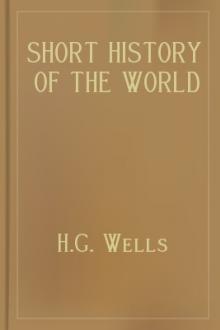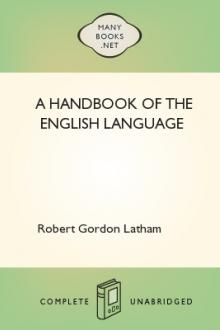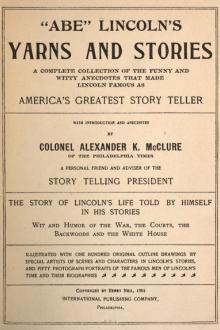A Short History of the World, H. G. Wells [beach books .TXT] 📗

- Author: H. G. Wells
- Performer: -
Book online «A Short History of the World, H. G. Wells [beach books .TXT] 📗». Author H. G. Wells
(From an old print)
Throughout his books, a little disguised by the necessity of seeming to square it all with orthodoxy for fear of the prison and worse, Roger Bacon shouted to mankind, “Cease to be ruled by dogmas and authorities; look at the world!” Four chief sources of ignorance he denounced; respect for authority, custom, the sense of the ignorant crowd, and the vain, proud unteachableness of our dispositions. Overcome but these, and a world of power would open to men: —
“Machines for navigating are possible without rowers, so that great ships suited to river or ocean, guided by one man, may be borne with greater speed than if they were full of men. Likewise cars may be made so that without a draught animal they may be moved cum impetu inœstimable, as we deem the scythed chariots to have been from which antiquity fought. And flying machines are possible, so that a man may sit in the middle turning some device by which artificial wings may beat the air in the manner of a flying bird.”
So Roger Bacon wrote, but three more centuries were to elapse before men began any systematic attempts to explore the hidden stores of power and interest he realized so clearly existed beneath the dull surface of human affairs.
But the Saracenic world not only gave Christendom the stimulus of its philosophers and alchemists; it also gave it paper. It is scarcely too much to say that paper made the intellectual revival of Europe possible. Paper originated in China, where its use probably goes back to the second century B.C. In 751 the Chinese made an attack upon the Arab Moslems in Samarkand; they were repulsed, and among the prisoners taken from them were some skilled papermakers, from whom the art was learnt. Arabic paper manuscripts from the ninth century onward still exist. The manufacture entered Christendom either through Greece or by the capture of Moorish paper-mills during the Christian reconquest of Spain. But under the Christian Spanish the product deteriorated sadly. Good paper was not made in Christian Europe until the end of the thirteenth century, and then it was Italy which led the world. Only by the fourteenth century did the manufacture reach Germany, and not until the end of that century was it abundant and cheap enough for the printing of books to be a practicable business proposition. Thereupon printing followed naturally and necessarily, for printing is the most obvious of inventions, and the intellectual life of the world entered upon a new and far more vigorous phase. It ceased to be a little trickle from mind to mind; it became a broad flood, in which thousands and presently scores and hundreds of thousands of minds participated.
One immediate result of this achievement of printing was the appearance of an abundance of Bibles in the world. Another was a cheapening of school-books. The knowledge of reading spread swiftly. There was not only a great increase of books in the world, but the books that were now made were plainer to read and so easier to understand. Instead of toiling at a crabbed text arid then thinking over its significance, readers now could think unimpeded as they read. With this increase in the facility of reading, the reading public grew. The book ceased to be a highly decorated toy or a scholar’s mystery. People began to write books to be read as well as looked at by ordinary people. They wrote in the ordinary language and not in Latin. With the fourteenth century the real history of the European literature begins.
So far we have been dealing only with the Saracenic share in the European revival. Let us turn now to the influence of the Mongol conquests. They stimulated the geographical imagination of Europe enormously. For a time under the Great Khan, all Asia and Western Europe enjoyed an open intercourse; all the roads were temporarily open, and representatives of every nation appeared at the court of Karakorum. The barriers between Europe and Asia set up by the religious feud of Christianity and Islam were lowered. Great hopes were entertained by the papacy for the conversion of the Mongols to Christianity. Their only religion so far had been Shumanism, a primitive paganism. Envoys of the Pope, Buddhist priests from India, Parisian and Italian and Chinese artificers, Byzantine and Armenian merchants, mingled with Arab officials and Persian and Indian astronomers and mathematicians at the Mongol court. We hear too much in history of the campaigns and massacres of the Mongols, and not enough of their curiosity and desire for learning. Not perhaps as an originative people, but as transmitters of knowledge and method their influence upon the world’s history has been very great. And everything one can learn of the vague and romantic personalities of Jengis or Kublai tends to confirm the impression that these men were at least as understanding and creative monarchs as either that flamboyant but egotistical figure Alexander the Great or that raiser of political ghosts, that energetic but illiterate theologian Charlemagne.
One of the most interesting of these visitors to the Mongol Court was a certain Venetian, Marco Polo, who afterwards set down his story in a book. He went to China about 1272 with his father and uncle, who had already once made the journey. The Great Khan had been deeply impressed by the elder Polos; they were the first men of the “Latin” peoples he had seen; and he sent them back with enquiries for teachers and learned men who could explain Christianity to him, and for various other European things that had aroused his curiosity. Their visit with Marco was their second visit.
Note evidence in attire of knowledge of early European explorers
(In the British Museum)
The three Polos started by way of Palestine and not by the Crimea, as in their previous expedition. They had with them a gold tablet and other indications from the Great Khan that must have greatly facilitated their journey. The Great Khan had asked for some oil from the lamp that burns in the Holy Sepulchre at Jerusalem; and so thither they first went, and then by way of Cilicia into Armenia. They went thus far north because the Sultan of Egypt was raiding the Mongol domains at this time. Thence they came by way of Mesopotamia to Ormuz on the Persian Gulf, as if they contemplated a sea voyage. At Ormuz they met merchants from India. For some reason they did not take ship, but instead turned northward through the Persian deserts, and so by way of Balkh over the Pamir to Kashgar, and by way of Kotan and the Lob Nor into the Hwang-ho valley and on to Pekin. At Pekin was the Great Khan, and they were hospitably entertained.
(In the British Museum)
Marco particularly pleased Kublai; he was young and clever, and it is clear he had mastered the Tartar language very thoroughly. He was given an official position and sent on several missions, chiefly in south-west China. The tale he had to tell of vast stretches of smiling and prosperous country, “all the way excellent hostelries for travellers,” and “fine vineyards, fields, and gardens,” of “many abbeys” of Buddhist monks, of manufactures of “cloth of silk and gold and many fine taffetas,” a “constant succession of cities and boroughs,” and so on, first roused the incredulity and then fired the imagination of all Europe. He told of Burmah, and of its great armies with hundreds of elephants, and how these animals were defeated by the Mongol bowmen, and also of the Mongol conquest of Pegu. He told of Japan, and greatly exaggerated the amount of gold in that country. For three years Marco ruled the city of Yang-chow as governor, and he probably impressed the Chinese inhabitants as being little more of a foreigner than any Tartar would have been. He may also have been sent on a mission to India. Chinese records mention a certain Polo attached to the imperial council in 1277, a very valuable confirmation of the general truth of the Polo story.
The publication of Marco Polo’s travels produced a profound effect upon the European imagination. The European literature, and especially the European romance of the fifteenth century, echoes with the names in Marco Polo’s story, with Cathay (North China) and Cambulac (Pekin) and the like.
(In the British Museum)
Two centuries later, among the readers of the Travels of Marco Polo was a certain Genoese mariner, Christopher Columbus, who conceived the brilliant idea of sailing westward round the world to China. In Seville there is a copy of the Travels with marginal notes by Columbus. There were many reasons why the thought of a Genoese should be turned in this direction. Until its capture by the Turks in 1453 Constantinople had been an impartial trading mart between the Western world and the East, and the Genoese had traded there freely. But the “Latin” Venetians, the bitter rivals of the Genoese, had been the allies and helpers of the Turks against the Greeks, and with the coming of the Turks Constantinople turned an unfriendly face upon Genoese trade. The long forgotten discovery that the world was round had gradually resumed its sway over men’s minds. The idea of going westward to China was therefore a fairly obvious one. It was encouraged by two things. The mariner’s compass had now been invented and men were no longer left to the mercy of a fine night and the stars to determine the direction in which they were sailing, and the Normans, Catalonians and Genoese and Portuguese had already pushed out into the Atlantic as far as the Canary Isles, Madeira and the Azores.
Yet Columbus found many difficulties before he could get ships to put his idea to the test. He went from one European Court to another. Finally at Granada, just won from the Moors, he secured the patronage of Ferdinand and Isabella, and was able to set out across the unknown ocean in three small ships. After a voyage of two months and nine days he came to a land which he believed to be India, but which was really a new continent, whose distinct existence the old world had never hitherto suspected. He returned to Spain with gold, cotton, strange beasts and birds, and two wild- eyed painted Indians to be baptized. They were called Indians because, to the end of his days, he believed that this land he had found was India. Only in the course of several years did men begin to realize that the whole new continent of America was added to the world’s resources.
The success of Columbus stimulated overseas enterprise enormously. In 1497 the Portuguese sailed round Africa to India, and in 1515 there were Portuguese ships in Java. In 1519 Magellan, a Portuguese sailor in Spanish employment, sailed out of Seville westward with five ships, of which one, the Vittoria, came back up the river to Seville in 1522, the first ship that had ever circumnavigated the world. Thirty-one men were aboard her, survivors of two-hundred-and- eighty who had started. Magellan himself had been killed in the Philippine Isles.
Printed paper books, a new realization of the round world as a thing altogether attainable, a new vision of strange lands, strange animals and plants, strange manners and customs, discoveries overseas and in the skies and in the ways and materials of life burst upon the European mind. The Greek classics, buried and forgotten for so long, were speedily being printed and studied, and were colouring men’s thoughts with the dreams





Comments (0)